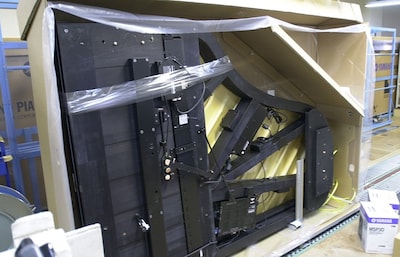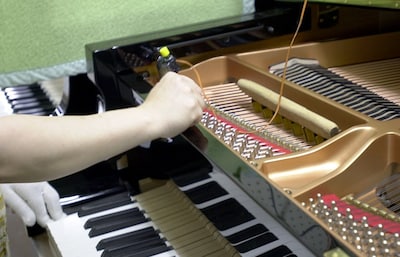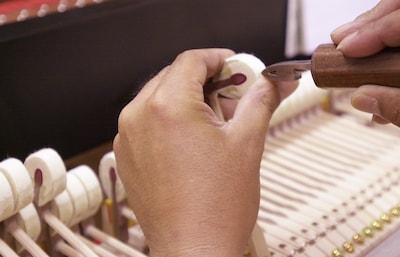More Adjustments and Then Finishing
More than a Thousand Adjustments
The automatic key pressing machine is applied one more time after the seasoning is completed. Work then proceeds to the second stage of adjustments, and to final finishing.
Adjustment fine-tunes the movement of the keyboard and action, ensuring that the instrument responds accurately to the pianist's touch. This involves leveling the height of the keys and adjusting the key drop as described previously, and also includes the process of regulating the action. There are more than 10 adjustments for each key, and since there are 88 keys, it means that a total of over a thousand separate adjustments must be made.

Ensuring Flawless Action Movement
After installing the three legs and the pedals, the process moves to the finish tuning. Tuning is the process of adjusting the strings to have the correct pitch to produce the musical scale. In the keys which have three strings, the middle string is tuned first. A tool called a "mute" is inserted to silence the strings on either side. The right and left strings are then tuned based on the pitch of the middle string.
In addition, a finish tuning is performed, and the action is regulated to ensure flawless movement. Here, a senior piano technician with many years of experience takes charge. The closer a piano gets to completion, the greater the requirement for a master piano technician to perform the adjustments.
Voicing the Piano by Adjusting the Hammer Felts
Next is the voicing process. This task adjusts the hardness and resiliency of the hammer felts to alter the tone and balance the notes. Specifically, in a process called filing, sandpaper is used to smooth the surface of the hammer felt and remove irregular fuzzing, to soften the felt when it has become too compressed, and to re-shape the hammer head. For notes that are strung with two or three strings, the hammer is shaped so that it strikes each string in the same way.
Finished at Last!
When voicing is finished, the piano is given a complete inspection. If the relationship between the keyboard and the action is satisfactory, the music desk is installed, and a detailed check for dirt and blemishes is performed. The piano is finally complete. Pianos destined for customers in Japan are wrapped in heavy padded blankets (futons), and instruments for overseas customers which are shipped by ocean freight are wrapped in moisture-proof plastic film and sealed in vinyl after legs are removed.


Musical Instrument Guide : Piano Contents
Origins
Structure
How to Play
How the Instrument is Made
Choosing an Instrument
Care and Maintenance
Trivia
- The White Keys and Black Keys Were Reversed on Pianos in Mozart's Day
- Did Mozart's Piano Have a Pedal-Board?
- Piano with Automatic Accompaniment System in Beethoven's Day
- The Pianos Beloved by the Great Master, Sviatoslav Richter
- The Optimal Material for Piano Frames Is Also Ideal for Motorcycle Engines
- The Piano Soundboard Is a Board that Also Stops Vibrations
- Why Can't There Be More Than 88 Keys on a Piano?
- Why a Grand Piano Keyboard Feels Heavier Than an Upright Keyboard?



